How Common Are Transvaginal Mesh Complications?
- Last Updated: April 15th, 2024

Attorney Jessie Paluch, founder of TruLaw, has over 25 years of experience as a personal injury and mass tort attorney, and previously worked as an international tax attorney at Deloitte. Jessie collaborates with attorneys nationwide — enabling her to share reliable, up-to-date legal information with our readers.
Legally Reviewed
This article has been written and reviewed for legal accuracy and clarity by the team of writers and legal experts at TruLaw and is as accurate as possible. This content should not be taken as legal advice from an attorney. If you would like to learn more about our owner and experienced injury lawyer, Jessie Paluch, you can do so here.
Fact-Checked
TruLaw does everything possible to make sure the information in this article is up to date and accurate. If you need specific legal advice about your case, contact us by using the chat on the bottom of this page. This article should not be taken as advice from an attorney.
Key takeaways:
- Transvaginal mesh complications are a significant concern for women after surgeries for pelvic organ prolapse or stress urinary incontinence, with issues like mesh erosion and chronic pain being common.
- Monitoring symptoms such as ongoing pelvic pain, abnormal bleeding, and changes in urinary habits is important for the early detection of mesh-related problems.
- Treatment of transvaginal mesh complications typically requires surgical intervention, which may include removal of the mesh or additional reconstructive procedures to mend any damage.
Overview of Transvaginal Mesh Complications
On this page, we will discuss an overview of how common are transvaginal mesh complications, statistical evidence of transvaginal mesh complications, ethical considerations of transvaginal mesh, and much more.
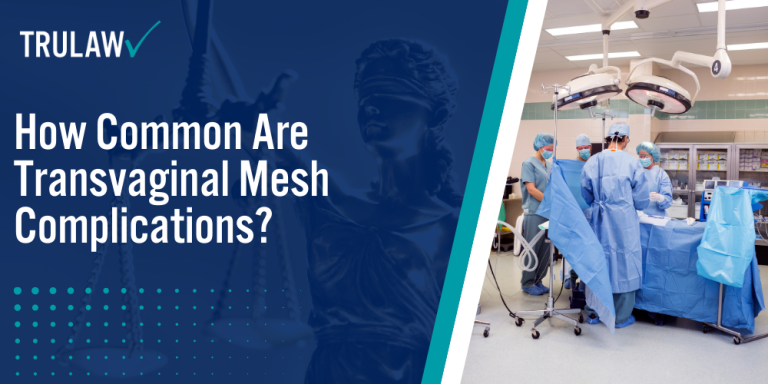
Intro to Transvaginal Mesh Complications
Transvaginal mesh has been widely used to treat pelvic organ prolapse (POP) and stress urinary incontinence (SUI).
The transvaginal mesh complications most commonly reported include:
- Tissue Erosion and Pain: Mesh erosion through the vaginal wall is a prevalent issue, leading to pelvic pain and discomfort during intercourse.
- Mesh Erosion and Urinary Issues: Vaginal mesh erosion is the most common complication, which can also contribute to urinary problems and the recurrence of prolapse or incontinence.
- Regulatory Response to Complications: The FDA’s ban on transvaginal mesh for pelvic organ prolapse repair raises awareness of the severity of complications some women face.
- Challenges in Treatment: Mesh complications such as infection, pain, and dyspareunia (pain experienced by a partner during intercourse) necessitate best practices in diagnosis and treatment.
Our experienced team of product liability attorneys at TruLaw estimates settlement values may reach as much as $150,000 to $400,000, depending on the severity of the transvaginal mesh complications.
Use the chat on this page to find out if you qualify to seek compensation in the transvaginal mesh lawsuit today.
Table of Contents
Medical Conditions For Transvaginal Mesh Usage
Transvaginal mesh has been primarily used to address specific pelvic floor disorders that compromise the quality of life in many women.
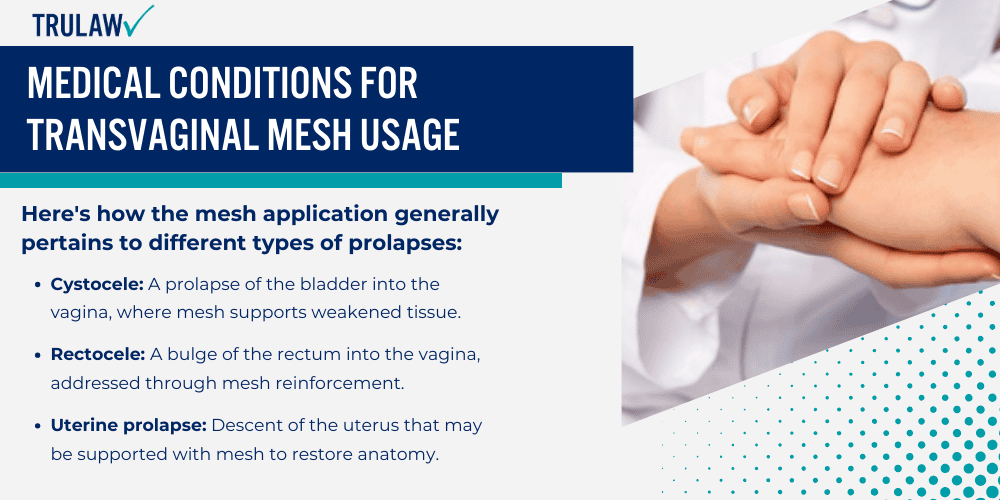
This section discusses the two key medical conditions that have historically warranted the use of transvaginal mesh: Pelvic Organ Prolapse (POP) and Stress Urinary Incontinence (SUI).
Pelvic Organ Prolapse and Mesh
Pelvic organ prolapse occurs when pelvic organs, such as the bladder, uterus, or rectum, prolapse or bulge into the vaginal canal due to the weakening of the pelvic floor muscles.
Mesh has traditionally been used to treat pelvic organ prolapse and repair pelvic organ prolapse, resulting in pelvic reconstructive surgery.
Here’s how the mesh application generally pertains to different types of prolapses:
- Cystocele: A prolapse of the bladder into the vagina, where mesh supports weakened tissue.
- Rectocele: A bulge of the rectum into the vagina, addressed through mesh reinforcement.
- Uterine prolapse: Descent of the uterus that may be supported with mesh to restore anatomy.
- Vaginal vault prolapse: After hysterectomy, the top of the vagina is supported with mesh if it descends.
As of April 2019, the FDA has banned the use of transvaginal mesh for POP due to safety concerns, as supported by the Cleveland Clinic’s discussion on Surgical Mesh.
Stress Urinary Incontinence and Mesh
Stress urinary incontinence, the involuntary leakage of urine during physical activity or exertion, is the second condition for which mesh procedures have been utilized.
Transvaginal mesh aimed to provide additional support to urethral and bladder neck support structures.
Factors leading to the consideration of mesh for SUI include:
- Childbirth trauma: Weakens the muscles needed for urinary control.
- Hormonal changes: Post-menopausal changes can exacerbate incontinence.
- Intrinsic sphincter deficiency: Lack of closure pressure in the urethra.
- Prior pelvic surgery: Previous operations can affect the pelvic floor’s stability.
The Mayo Clinic provides insights on the use of surgical mesh in female pelvic reconstructive surgery, including for conditions like stress urinary incontinence.
However, mesh usage for SUI has become less frequent due to associated complications and advancements in other surgical techniques.
Transvaginal Mesh Complications: Health Risks
Transvaginal mesh complications bring a host of health risks that can significantly impact a patient’s quality of life.
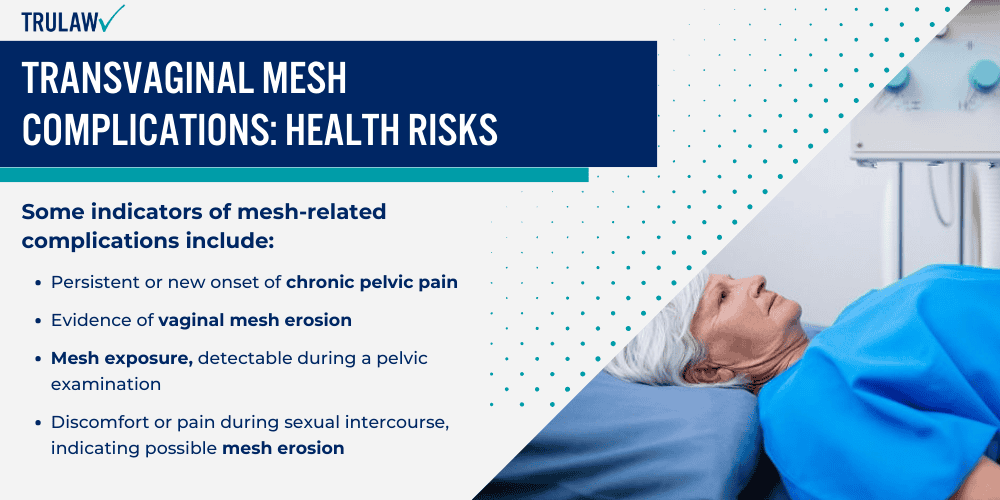
These complications may range from mild to severe and often require medical attention or additional surgical treatment.
Identifying Mesh Complications
Detecting mesh complications is a critical step in ensuring timely treatment and reducing further health risks.
Some indicators of mesh-related complications include:
- Persistent or new onset of chronic pelvic pain
- Evidence of vaginal mesh erosion
- Mesh exposure, detectable during a pelvic examination
- Discomfort or pain during sexual intercourse, indicating possible mesh erosion
- Noticeable voiding dysfunction with urinary problems
- Unexpected instances of fecal incontinence
Risk Factors for Mesh Complications
Certain factors can increase the likelihood of experiencing mesh complications.
These risk factors include:
- Previous pelvic surgery, which can influence the current mesh positioning and integration
- A history of pelvic radiation therapy
- Concomitant health conditions, such as diabetes, can affect tissue healing
- Smoking, which impairs tissue oxygenation and healing
Common Complications from Mesh Procedures
After undergoing mesh placement, patients may face a variety of complications.
Commonly reported mesh-related complications consist of the following:
- Vaginal mesh erosion, where the mesh erodes through the vaginal wall
- Mesh exposure, with parts of the mesh becoming visible at the site of the surgery
- Painful intercourse (dyspareunia) due to mesh irritation
- Voiding dysfunction, ranging from urinary retention to incontinence
- Chronic pelvic pain, persisting long after the initial surgery
- Urinary problems, including urgency, frequency, and discomfort
Each of these complications can have significant ramifications for the patient’s everyday activities and overall well-being.
For those experiencing severe vaginal mesh complications, surgical treatment may be necessary to remove the mesh and alleviate symptoms.
However, patients should discuss the potential risks and benefits of further surgery with their healthcare provider.
Surgical Procedures Involving Transvaginal Mesh
Transvaginal mesh procedures are critical for treating pelvic floor disorders yet require a comprehensive understanding of the surgical techniques and potential postoperative complications.
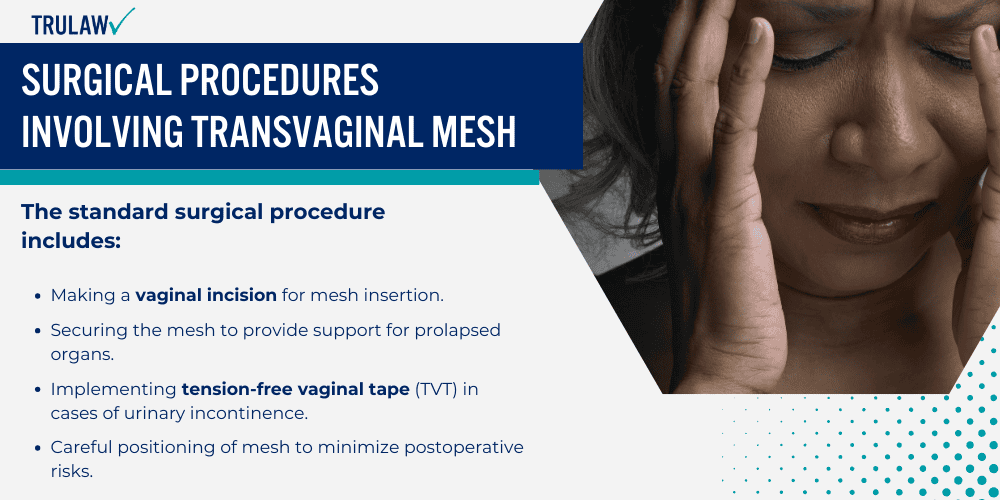
Mesh Placement and Surgery
Transvaginal mesh surgery is commonly employed in pelvic organ prolapse surgery, aiming to provide additional support when pelvic tissues are weakened.
Pelvic reconstructive surgery often involves the insertion of surgical mesh devices to reinforce the vaginal wall.
The standard surgical procedure includes:
- Making a vaginal incision for mesh insertion.
- Securing the mesh to provide support for prolapsed organs.
- Implementing tension-free vaginal tape (TVT) in cases of urinary incontinence.
- Careful positioning of mesh to minimize postoperative risks.
Mesh placement must be meticulously performed to reduce the chances of complications.
Surgeons are trained to navigate the complexities of initial surgery and are skilled in determining the appropriate surgical technique for each patient.
Postoperative Considerations
Following the surgery, patients are monitored for signs of success and any immediate complications.
Key aspects of postoperative care include:
- Ensuring that the mesh is properly integrated and supports the pelvic organs.
- Monitoring for signs of infection at the vaginal incision site.
- Observing the patient’s ability to return to normal activities.
- Advising on follow-up visits to assess the long-term performance of the mesh.
After pelvic surgery, it is crucial to provide patients with detailed information regarding their recovery timeline and the symptoms they should report if experienced.
Knowledge of potential complications is essential so that they can be addressed promptly if they arise.
Treating Transvaginal Mesh Complications
Transvaginal mesh complications can be distressing and challenging, requiring surgeons to make careful decisions regarding mesh removal, mesh excision, and potential native tissue repair.
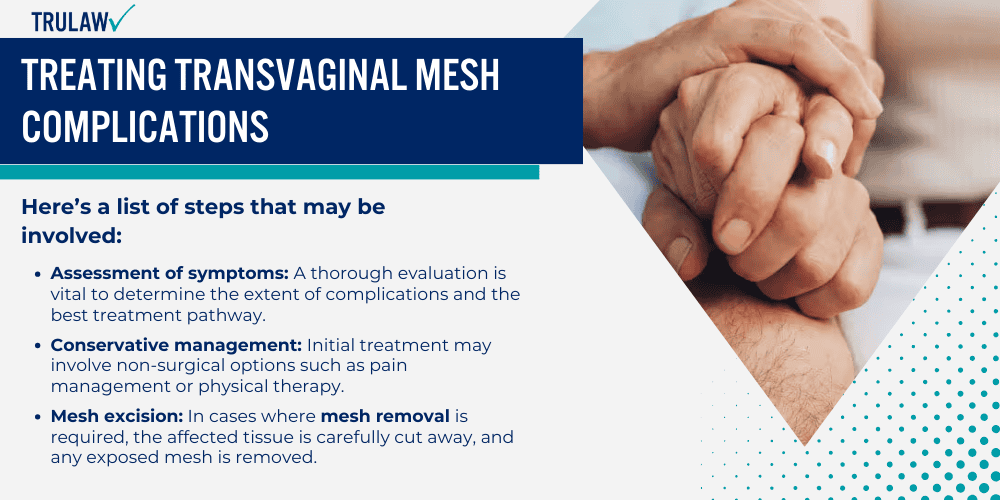
Managing Mesh Complications
When it comes to managing mesh complications, a multi-faceted approach is often necessary.
Before detailing the potential steps within mesh removal surgery, it is important to understand that each case is unique and requires individual assessment.
Here’s a list of steps that may be involved:
- Assessment of symptoms: A thorough evaluation is vital to determine the extent of complications and the best treatment pathway.
- Conservative management: Initial treatment may involve non-surgical options such as pain management or physical therapy.
- Mesh excision: In cases where mesh removal is required, the affected tissue is carefully cut away, and any exposed mesh is removed.
- Full or partial mesh removal: Depending on the complication, a surgeon may opt for partial or complete mesh removal surgery.
- Revision surgery: Some patients may require additional surgeries to correct or improve the initial vaginal prolapse repair.
- Follow-up care: Proper postoperative care is essential for recovery and monitoring for any recurrence of symptoms.
Alternatives to Mesh in Pelvic Surgeries
Alternative solutions to transvaginal mesh for POP repair and vaginal prolapse repair offer options for those seeking a different approach or experiencing complications.
These native tissue repair methods use the patient’s tissues to provide support.
Here we have several alternatives:
- Native tissue repair: Utilizes the body’s own tissues to support pelvic organs without the use of synthetic mesh.
- Colporrhaphy: A traditional procedure for recurrent prolapse, focusing on reinforcing the vaginal wall.
- Sacrospinous ligament fixation: This surgical procedure attaches the vaginal vault to the sacrospinous ligament.
- Uterosacral ligament suspension: An approach using the uterosacral ligaments for support in vaginal prolapse repair.
Considering the minimally invasive nature and reduced risk of complications, many patients and clinicians favor these tissue-based techniques.
However, the choice of procedure will depend on individual patient circumstances, including the severity of prolapse and previous surgical history.
Legal and Ethical Considerations of Transvaginal Mesh Complications
Transvaginal mesh complications have raised significant legal and ethical questions about patient safety and the medical device industry’s responsibilities.
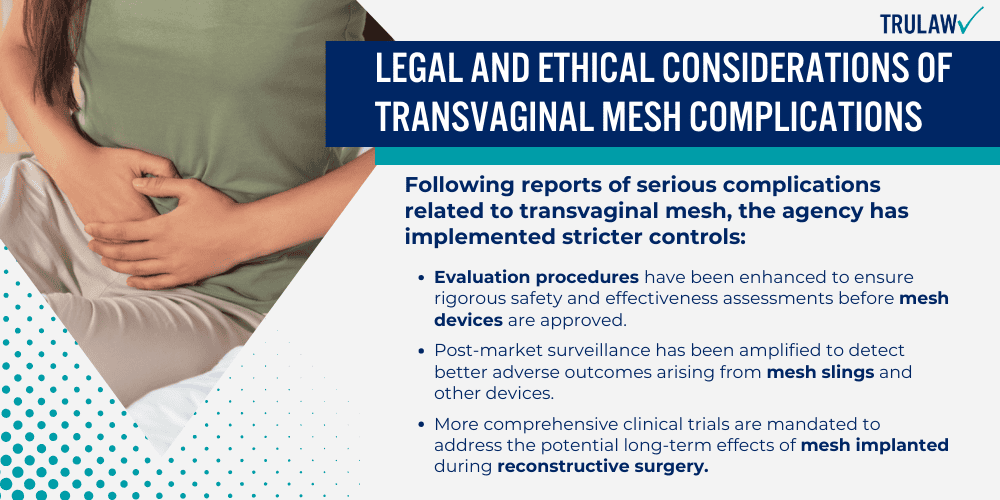
These concerns necessitate a closer examination of regulatory processes and patient advocacy measures.
Regulation of Mesh Devices
The Food and Drug Administration (FDA) plays a crucial role in monitoring medical devices, including those for pelvic floor disorders.
Following reports of serious complications related to transvaginal mesh, the agency has implemented stricter controls:
- Evaluation procedures have been enhanced to ensure rigorous safety and effectiveness assessments before mesh devices are approved.
- Post-market surveillance has been amplified to detect better adverse outcomes arising from mesh slings and other devices.
- More comprehensive clinical trials are mandated to address the potential long-term effects of mesh implanted during reconstructive surgery.
- Increased reporting requirements for manufacturers have been established to ensure timely information on the risks associated with devices.
Patient Education and Advocacy
Empowering patients through education about transvaginal mesh is essential for informed consent and self-advocacy.
Here are the key educational and advocacy initiatives that have gained prominence:
- Comprehensive discussions about alternative treatments for pelvic floor disorders and potential mesh complications.
- Detailed pre-surgical counseling on risks such as vaginal bleeding, infection, or bladder neck obstruction following a procedure.
- Development of patient-focused literature that outlines steps to take if serious complications arise post-surgery.
- Promotion of patient advocacy groups that provide support to individuals affected by negative outcomes related to transvaginal mesh.
Frequently Asked Questions
-
What are the symptoms of bladder mesh problems?
Patients may experience symptoms such as pelvic pain, urinary problems, or pain during intercourse indicating bladder mesh issues.
Infections or bleeding are also prominent symptoms associated with bladder mesh complications.
-
How is mesh erosion treated?
When mesh erosion occurs, non-surgical options like vaginal cream may be employed; however, surgical intervention is often required to remove the exposed mesh.
Each case is evaluated individually to determine the most appropriate course of action.
-
What is the difference between a bladder sling and a surgical mesh?
A bladder sling specifically supports the urethra or bladder neck to manage urinary incontinence.
In contrast, surgical mesh is utilized more broadly for reinforcing weakened pelvic tissues and supporting prolapsed organs.
-
What are the indicators of pelvic mesh complications?
Pelvic mesh complications may manifest as ongoing pelvic or groin pain, abnormal vaginal discharge, or recurrent urinary tract infections.
The sensation of the mesh being palpable through the vaginal wall may also indicate a complication.
-
What complications can arise years after a bladder sling procedure?
Long-term complications following a bladder sling procedure may include chronic pain, mesh shrinkage, and tissue perforation.
These complications can significantly impact a patient’s quality of life and may require additional surgeries.
-
What are the potential complications following a hysterectomy involving mesh?
Following a hysterectomy involving mesh, complications such as mesh migration, organ perforation, and abnormal bleeding can occur.
Persistent pain and issues with sexual function are also potential long-term complications.

Experienced Attorney & Legal SaaS CEO
With over 25 years of legal experience, Jessie is an Illinois lawyer, a CPA, and a mother of three. She spent the first decade of her career working as an international tax attorney at Deloitte.
In 2009, Jessie co-founded her own law firm with her husband – which has scaled to over 30 employees since its conception.
In 2016, Jessie founded TruLaw, which allows her to collaborate with attorneys and legal experts across the United States on a daily basis. This hypervaluable network of experts is what enables her to share reliable legal information with her readers!
You can learn more about the Transvaginal Mesh Lawsuit by visiting any of our pages listed below:
Here, at TruLaw, we’re committed to helping victims get the justice they deserve.
Alongside our partner law firms, we have successfully collected over $3 Billion in verdicts and settlements on behalf of injured individuals.
Would you like our help?
At TruLaw, we fiercely combat corporations that endanger individuals’ well-being. If you’ve suffered injuries and believe these well-funded entities should be held accountable, we’re here for you.
With TruLaw, you gain access to successful and seasoned lawyers who maximize your chances of success. Our lawyers invest in you—they do not receive a dime until your lawsuit reaches a successful resolution!
Do you believe you’re entitled to compensation?
Use our Instant Case Evaluator to find out in as little as 60 seconds!
Camp Lejeune’s water contamination issue spanned several decades starting in the 1950s. Exposure to these chemicals has been linked to various serious health issues, including cancer, organ diseases, and death.
Research is increasingly suggesting a link between the use of Tylenol during pregnancy and the development of neurodevelopmental disorders, such as autism and ADHD, in infants.
Legal action is being taken against manufacturers of Aqueous Film-Forming Foam (AFFF), a chemical used in fighting fires. The plaintiffs allege that exposure to the foam caused health issues such as cancer, organ damage, and birth and fertility issues.
Here, at TruLaw, we’re committed to helping victims get the justice they deserve.
Alongside our partner law firms, we have successfully collected over $3 Billion in verdicts and settlements on behalf of injured individuals.
Would you like our help?


